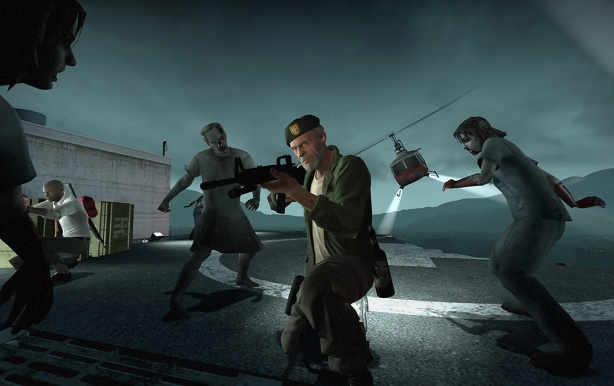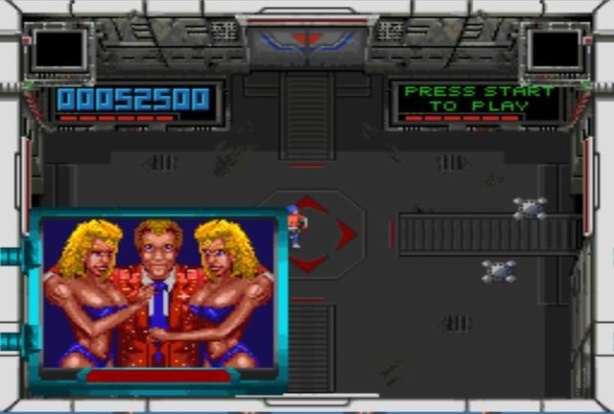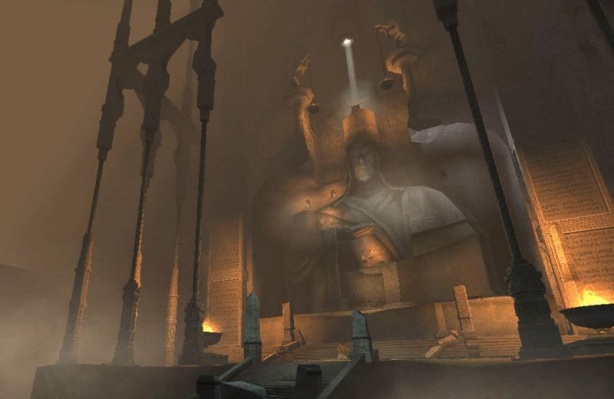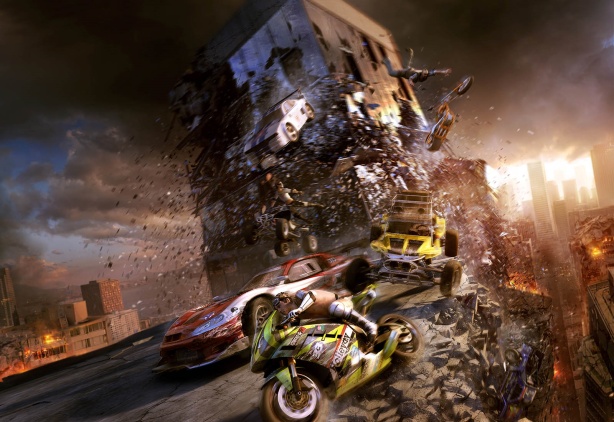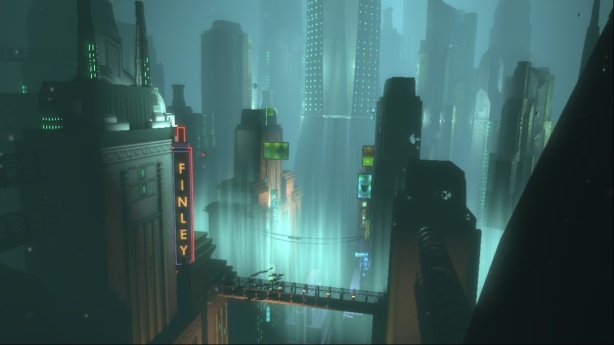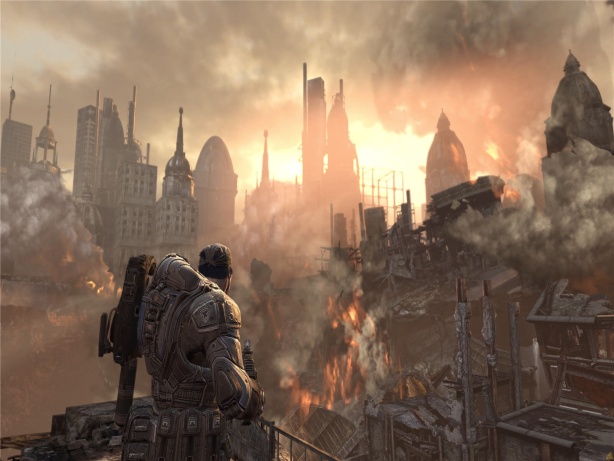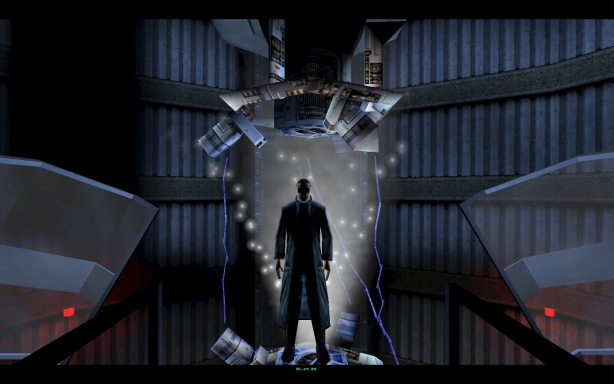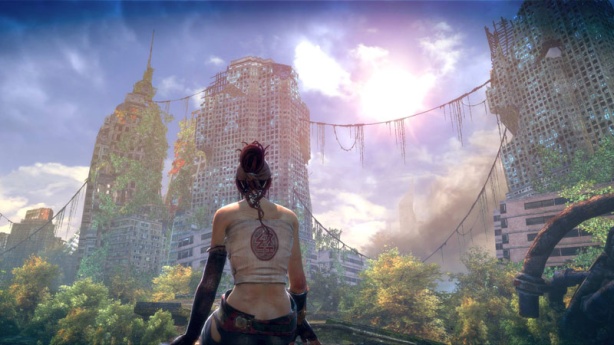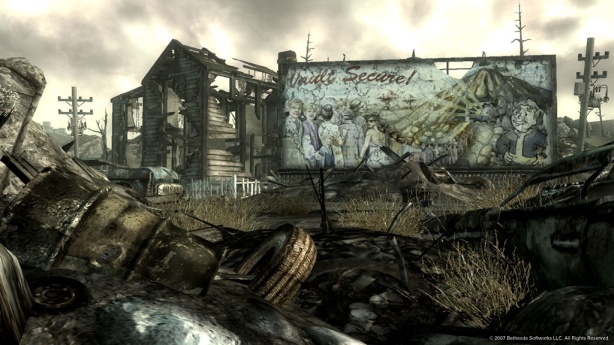The Vault: Top Ten Apocalyptic Games
 The book of Revelation describes the Apocalypse as the complete and final destruction of all things. By this definition, it would be very hard to create a truly post-apocalyptic video game. How much fun could it possibly be to control a non-existent being in an empty universe of nothingness?
The book of Revelation describes the Apocalypse as the complete and final destruction of all things. By this definition, it would be very hard to create a truly post-apocalyptic video game. How much fun could it possibly be to control a non-existent being in an empty universe of nothingness?
Consequently, it is necessary for us to look towards Google’s more lenient (and less Biblical) definition of the Apocalypse, which refers to “catastrophic destruction on a physical, environmental or social level”. This wider interpretation of the word allows us to appreciate the myriad ways in which video games over the years have depicted this cataclysmal event and its aftermath.
Some games imagine an environmental apocalypse that leaves creatures fighting for their lives in a barren, hostile planet. Many present dystopian civilisations that have emerged following irrevocable social breakdown, whilst others explore the reverse scenario of a purely human apocalypse that does not affect the world around it. A few games explore the apocalypse itself, putting players in the midst of a crumbling universe and letting them fight their way out.
Games present a unique opportunity for us to explore places we will never see. The apocalypse is something we all hope we will never experience, and yet the end of times fascinates us. Here is a list of the best, most terrifying and most imaginative interpretations of the apocalypse ever committed to pixels.
10: Left 4 Dead (Turtle Rock Studios, Valve South: 2008)
Portraying an archetypal zombie apocalypse, Left 4 Dead puts players in the midst of an unrelenting onslaught of mindless ex-humans and lets them fight their way through. With a strong emphasis on teamwork and co-operation, Left 4 Dead presents a horrific scenario which it is still possible to escape from.
Taking its cues from classic B-movies such as Dawn of the Dead, Left 4 Dead features a cast of archetypal horror protagonists: the biker, the Vietnam veteran, the repressed wage slave and the final girl. These characters must get from one end of any given level to the other, using a variety of guns and explosives to clear a path through the zombie horde. At the end of each level is an escape vehicle, be it a helicopter, truck or boat, meaning that there is a tantalizing sense throughout the game that there is an escape route just around the corner. The fact that these vehicles perpetually fail to take the survivors to safety not only enables the game’s progression, but it also mirrors the terrifying breakdown of society following mass infection, not to mention the brain functions of the infected themselves.
It is Frances, Bill, Louis and Zoey’s perpetual movement away from the tragedy’s epicentre which makes Left 4 Dead so exciting. Human nature will not accept its own demise, so their fight for survival is particularly harrowing. Add to this the fact that players are forced to help each other if they are to survive, and you have the recipe for one of the most exhilarating co-operative experiences a gamer can have.
9: Super Smash TV (Williams, Beam Soft, 1990)
“The year is 1999. Television has adapted to the more violent nature of man. The most popular form of television remains the game show. One show in particular has dominated the ratings. That show is Smash TV, the most violent game show of all time.”
In hindsight, it’s amusing that Super Smash TV, a game about a cultural apocalypse played out through a television game show, should be set in the same year that real-life cultural nadir Big Brother was first aired. Although you could argue that Super Smash TV’s depiction of a game show where people are bludgeoned, electrocuted and shot in pursuit of prizes (the best of which being: “A Brand New Toaster!”) is even more barbaric than Endemol’s “social experiment”, there’s still something disturbingly prophetic about the way in which SSTV’s ghoulishly perma-tanned host gleefully announces each of the game’s gruesome rounds.
Super Smash TV initially drew inspiration from the 1987 Schwarzenegger classic The Running Man, but the intervening years have seen life imitate art to such an extent that the game’s bloody extremism now looks more like satire than fantasy. Although the gory premise makes for compulsive co-operative gameplay (in which teamwork is even more vital than in Left 4 Dead), it’s the creepy neon-coloured aesthetic which marks the game out as a truly horrific vision of the fall of civilization.
8: Prince of Persia: The Sands of Time (Ubisoft Montreal, 2003)
In this game, the titular Prince brings about the apocalypse by mistake when he inserts the Dagger of Time into a Maharaja’s giant Hourglass (easy now) having stolen both from India several weeks before. This releases The Sands of Time, a magical substance which not only gives the Prince power over time (good), but also turns every single living creature into a mindless sand zombie (very, very bad).
The unfortunate incident takes place in Azad, a stunning palace straight out of 1001 Arabian Nights. As one of only three living beings unaffected by the Sands (the others being Princess Farah and the moustache-twirling baddie), it’s up to the Prince to navigate the desolately beautiful palace and return the sands to their rightful place. Of course it’s fitting that the only way to avert the apocalypse is to literally rewind time, but what’s truly special about this game’s rendering of Armageddon is its lonely, pristine beauty.
Unlike many post-apocalyptic environments, which show signs of environmental disintegration, Azad is left almost untouched by the event that obliterates the lives of all its residents, meaning that the player is left to consider the emptiness of the palace’s opulence when there’s no-one around to enjoy it any more. Further to this, the end of civilization means that the Prince and Farah’s birthrights suddenly count for nothing; although they may be a Prince and a Princess in a palace, they’re still just two scared animals fighting for survival in a desolate and empty world.
7: MotorStorm: Apocalypse (Evolution Studios, 2011)
Many games explore the aftermath of the apocalypse, but few take as much delight in the event itself as MotorStorm: Apocalypse. The fact that the preposterous plot (which centres around a celebratory racing festival) is merely an excuse for the explosive action is entirely forgivable, especially when the result is so intense. Hollywood has shown us that people will react to the end of the world in different ways, so the fact that the cast of MotorStorm: Apocalypse chooses to celebrate it by racing around disintegrating cityscapes at breakneck speeds shouldn’t surprise anyone.
What makes MotorStorm: Apocalypse unique among apocalyptic games is the way it integrates the end of the world into the gameplay, rather than using it as a backdrop for the action. The game features truly dynamic landscapes, meaning that players must swerve to avoid falling buildings and leap across chasms which simply didn’t exist five seconds before. Unlike the majority of games, which either focus on the aftermath of Armageddon of have players trying to prevent it, MotorStorm: Apocalypse revels in the visceral power of the event itself. Mass destruction on Motorstorm’s epic scale is usually the preserve of the cutscene, so the ability to actually play through it marks this game out as an apocalyptic classic.
6: BioShock (2K Boston, 2007)
Bioshock melds the political with the fantastical in its rendering of a micro-apocalypse deep under the sea. Its story of society’s destruction at its own hands cuts right to the heart of our darkest fears for humanity, depicting the gruesome consequences of mankind’s attempts to live without limits. Built by idealist visionary Andrew Ryan, the underwater city of Rapture began life as a utopian project, a place where people could go to live out their full potential free from the fetters of church, state and morality. Science, too, was able to run free, meaning that Rapture’s population soon acquired superhuman powers afforded by Plasmid Technology, which permanently rewrote their genetic code.
As Jack, the player discovers Rapture long after the fall, with the devastating consequences of Plasmid addiction in full effect. Driven mad by the chemicals in their system, the lack of natural light and their insatiable desire to “improve” themselves yet more, Rapture’s inhabitants roam its dank corridors in search of “Little Sisters”, diseased human children and the carriers of raw genetic material. Their relentless pursuit of the Little Sisters and their utter disregard for anything besides their own power comes as a direct consequence of Rapture’s ideological origins, and is a dark shadow of mankind’s real life quest for glory.
5: Gears of War (Epic, 2006)
When the seventh generation hit in all its high-definition glory, it brought with it a slew of “gritty” games which depicted various dystopian worlds in shades of grey and brown that would have appeared sludge-like on older systems. Perhaps the archetypal dystopian world to emerge from this gloomy craze was Gears of War’s Sera, whose majesty was matched in scale only by the violence which scarred its streets.
Featuring some of the most beautiful architecture ever to be torn apart by battle, Gears of War tells a story that begins centuries before the game itself. Once rich with art and culture, Sera’s dwindling energy resources nearly resulted in a global economic crash until an almost limitless supply of Imulsion, a fuel source, was found below the planet’s crust. However, like all humans, Sera’s population was unable to handle such abundance, and a planet-wide conflict broke out. It was at this point, with mankind at its lowest physical and moral ebb, that a vast horde of subterranean monsters, the Locust, burrowed up from underground, and waged a far more terrible war on humanity.
Although Gears of War’s script and characterization are among the best in the shooter genre, what truly makes it special is the scale of its vision. Despite taking place in non-interactive corridor-shaped environments, the world feels utterly huge, and this is largely due to the quality of the design. The grandeur and opulence of the surroundings suggest a world utterly unprepared for the devastation soon to befall it, which makes the impact of the game’s brutal violence all the more intense.
4: Deus Ex (Ion Storm Inc., 2000)
A cyberpunk conspiracy thriller set in the near future, Deus Ex follows nanotechnoligically-augmented UNATCO agent JC Denton as he is tasked with bringing down the shady National Secessionist Forces. Although the game’s dystopian setting makes use of the power struggle between the populist NSF and the elitist UNATCO, events are spurred into motion by the apocalyptic “Gray Death”, a plague which ravages the world’s population.
Because the only known cure, Ambrosia, is in such short supply, it is only available to certain priviledged individuals, a fact which causes the stricken majority to launch devastating terrorist attacks. The game presents a horrific vision of a future in which corporations wield unimaginable power. In presenting gradual deteriation of society compounded by a biological apocalypse, Deus Ex circumnavigates straightforward questions of morality in favour of more complex ones about choice.
This choice is reflected in the gameplay itself, which has rarely been matched in terms of flexibility and depth. As Denton, the player is offered a remarkable number of options as to how they complete every mission. Choices are solidified by their ability to choose Denton’s nanotechnological augmentations, as they alter his already distorted body with more aftificial embellishments. Deus Ex presents a world where humanity in its purest biological form is weak: weak to disease, weak to corruption, and weak to physical attacks. It is only by gradually chipping away at our humanity, like Denton, that we can become truly powerful.
3: Enslaved: Odyssey to the West (Ninja Theory: 2010)
More often than not, video game apocalypses are rendered in palettes of grey and brown, indicating environmental, as well as social decay. How refreshing, then, to explore the America of Enslaved, a riot of acidic colour and rich foliage. Whilst the nature of the cataclysmic event that brought about America’s destruction is never quite made clear, what’s certain is that it destroyed society whilst leaving the earth’s flora and fauna intact, allowing nature to reclaim the land that had been denied it for centuries.
Part of what makes Enslaved so haunting is the mystery which surrounds almost every aspect of the world. What happened to humanity? Why are the “mechs” that were left behind after the war still intent on slaughtering every human they encounter? Where is the vast slave ship taking Monkey and Trip at the beginning of the game? And what is the origin of the visions that Monkey keeps experiencing through his slave headband?
As the story unfolds, Enslaved’s many layers reveal themselves. Far more than just an adventure story, the game uses its post-apocalyptic setting to explore questions of free will and consciousness. Is a life in such a harsh environment better than no life at all?
2: Half-Life 2 (Valve Corporation 2004)
Gloomy and desolate, Half Life 2’s Orwellian dystopia is horrific because it is believable. The apocalypse in question took place in the previous game as a group of scientists accidentally ripped a hole between dimensions. However, the resulting catastrophe (and the invasion of Earth by parasitic alien lifeforms) rather pales in comparision when compared to the exploitation of a stricken Earth by the Combine, a multidimensional empire which keeps humans under an oppressive and brutal regime.
Key to Half Life 2’s depiction of a post-apocalyptic world is its deft narration, which conveys plot, backstory and setting without removing control from the player. The game begins in City 17, a police state and central hub of the Combine’s operations, and the first hour sees the player (as talismanic bespectacled scientist Gordon Freeman) make their way through the streets whilst evading capture by Combine forces. Along the way, they see uniformed humans beaten by the Combine, faceless humanoid soldiers in helmets that resemble futuristic gas masks. Thus the game communicates the horror of the Combine’s regime without the need for cutscenes, making the player feel truly vulnerable
Keen to assist Freeman are the various citizens of the city, their individuality eroded by their matching jumpsuits. Whilst running through sparse apartments to escape his pursuers, Gordon passes a television broadcast by Combine puppet Wallace Breen. Curious players can make themselves a cup of tea and watch the entire broadcast, learning about the Combine energy field that prevents the citizens of City 17 from breeding, thus denying them one of their most basic human rights. Half Life 2’s apocalypse might be a distant memory, but its awful consequences are all too real.
1: Fallout 3 (Bethesda Game Studios, 2008)
Part-inspired by Cormac McCarthy’s astonishingly bleak novel The Road, Fallout 3 depicts the kind of post-apocalyptic world we all fear. Civilization and the environment have been irrevocably destroyed by nuclear war, and the creatures that remain must scavenge an existence from barren land and poisoned food. Despite the tiny settlements scattered across the ruins of Washington DC, a return to organized society seems an utter impossibility. Though set on an alternative timeline in which fashion, convention and manners froze in the 1950s, Fallout 3 presents a brutal reality in which even the rich are living in a burnt-out husk of a world.
The consequences of the nuclear holocaust are revealed to the player in subtle ways which underscore the vast tragedy which has taken place, an effect amplified by the player’s ability to explore the entire environment on foot. Whilst roaming the wastes, the player will discover a pair of corpses entwined on a bed next to several empty jars of Buffout, and will later follow a distress signal to a bomb-proof shelter, only to find it empty but for a scattering of children’s toys and some skeletons.
And despite the horror of the scenario, the humour that courses through the game is bewitching, rendering a profoundly depressing scenario darkly entertaining. Whilst the crater-based town of Megaton worships an unexploded nuclear bomb, the city of Underworld is solely populated by ghouls, the politically-incorrect term for decomposing humans who have been exposed to vast quantities of radiation. Indeed, all the characters in Fallout 3 are a product of their extreme environment, be it the feral children who roam the wastes alone, the delusional eccentrics who fancy themselves superheroes, or the hardened cynics who want nothing more than a quart of whiskey to block out the pain. The 1950s fashion aesthetic is utilized to great comic effect, and there’s something absurd about a primly-dressed housewife inhabiting a decrepit iron shack.
At its heart, Fallout 3 is a triumph of of dark imaginative vision, a superbly consistent depiction of the endurance of the human spirit when the world around it has been laid to waste.
The Vault is a monthly feature and will return on the second Friday of every month. Next Friday is Hall of Fame time!


